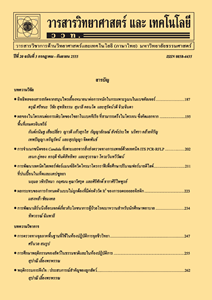ผลกระทบของเหตุการณ์เอนโซที่ส่งผลต่อการเปลี่ยนแปลงศักยภาพของแหล่งเพาะพันธุ์ยุงก้นปล่อง
Main Article Content
Abstract
Abstract
The objectives of this research are to study the impact of ENSO phenomena on the potential change of Anopheles breeding sites in Pha Bong sub-district, Mueang district, Mae Hong Son province. Interannual climate variability affects vegetation density, moisture, and land cover which change the potential of Anopheles breeding site in Pha Bong sub-district. The results showed that the La Nina event associated with rainfall increase and mean temperature decrease while the El Nino event correlated with rainfall and mean temperature increase. During the La Niña incident, it was found that the potential of Anopheles breeding sites has increased in the central and western parts of Pha Bong sub-district. Due to the study areas mostly are the deciduous forest and agricultural areas, the vegetation density and moisture changed with different climate conditions. Therefore, when the La Niña phenomenon occurs, which results in increased rainfall and lower temperatures, the vegetation covers the soil more densely and the moisture increases. While the El Nino event has resulted decreasing in the potential of the mosquito breeding sites due to reduced rainfall and increased temperatures results to decrease in vegetation, land covers and moisture.
Keywords: impact; ENSO; Anopheles breeding site, Pha Bong sub-district
Article Details
References
[2] Rebecca Lindsey, Global impacts of El Niño and La Niña, Available Source: https://www.climate.gov/news-features/feature d-images/global-impacts-el-ni%C3%B1o-a nd-la-ni%C3%B1a, January 2, 2018.
[3] Martens, P., Kovats, R.S., Nijhof, S., de Vries, P., Livermore, M.T.J., Bradley, D.J., Cox, J. and McMichael, A.J., 1999, Climate change and future population at risk of malaria, Global Environ. Change 9: S89-S107.
[4] Parham, P.E. and Michael, E., 2010, Modeling the Effects of Weather and Climate Change on Malaria Transmission, Environmental Health Perspectives 118 (5): pp. 620-626.
[5] Tonnang, H.E.Z., Kangalawe, R.Y.M. and Yanda, P.Z., 2010, Predicting and mapping malaria under climate change scenarios: The potential redistribution of malaria vectors in Africa, Malaria J. 9: 111-120.
[6] Githeko, A.K., Ototo, E.N. and Yan, G., 2012, Progress towards understanding the ecology and epidemiology of malaria in the Western Kenya Highlands: Opportuni ties and challenges for control under climate change risk, Acta Trop. 121: 19-25.
[7] Craig, M.H., Snow, R.W. and le Sueur, D., 1999, A climate-based distribution model of malaria transmission in Sub-Saharan Africa, Parasitol. Today 15: 105-111.
[8] ศุทธินี ดนตรี, 2549, ความรู้พื้นฐานด้านการสำรวจจากระยะไกล (Remote Sensing), ภาค วิชาภูมิศาสตร์ คณะสังคมศาสตร์ มหาวิทยาลัย เชียงใหม่, เชียงใหม่, 296 น.
[9] แคแสด มงคลสวัสดิ์ และชรัตน์ มงคลสวัสดิ์, 2552, แนวทางการใช้ดัชนีพืชพรรณและความชื้นของข้อมูลดาวเทียมหลายช่วงเวลาเพื่อติดตามตรวจสอบความแห้งแล้งจากสภาวะด้านชีพลักษณ์ของป่ามรสุมเขตร้อน, ว.สมาคมสำรวจข้อมูลระยะไกลและสารสนเทศภูมิศาสตร์แห่งประเทศไทย 10(2): 33-53.
[10] ขนิษฐา สุทธิบริบาล, สมนิมิตร พุกงาม และปิยพงษ์ ทองดีนอก, 2554, การประเมินค่าความชื้นในดินโดยใช้ดัชนีพืชพรรณบริเวณไร่มันสำปะหลัง อำเภอครบุรี จังหวัดนครราชสีมา, ว.วนศาสตร์ 30(3): 24-32.
[11] สมทัศน์ มะลิกุล, 2525, มาลาเรียวิทยา, โรงพิมพ์อักษรพัฒนา, กรุงเทพฯ.
[12] สดศรี ไทยทอง, 2540, ชีววิทยาและพันธุกรรมของเชื้อมาลาเรีย, ใน จันทรา เหล่าถาวร และศรชัย หลูอารีย์วุวรรณ (บรรณาธิการ), มาลาเรีย, โรงพิมพ์ชุมนุมสหกรณ์การเกษตรแหล่งประเทศไทย จำกัด, กรุงเทพฯ.
[13] USGS EarthExplorer, EarthExplorer, Avail able Source: http://earthexplorer.usgs.gov, March 1, 2016.
[14] Centers for Disease Control and Prevention, CDC Malaria Maps, Available Source: https: //www.cdc.gov/malaria/travelers/about_maps.html, January 2, 2018.
[15] Hassan, A.N., Nogoumy, N.E. and Kassem, H.A., 2013, Characterization of landscape features associated with mosquito breeding in Urban Cairo using remote sensing, Egypt. J. Remote Sensing Space Sci. 16: 63-69.
[16] Gao, B.C., 1996, NDWI-A normalized difference water index for remote sensensing of vegetation liquid water from space, Remote Sensing Environ. 58: 257-266.
[17] Smith, M.W., Macklin, M.G. and Thomas, C.J., 2013. Hydrological and geomorphological controls of malaria transmission, Earth Sci. Rev. 116: 109-127.
[18] Mabaso, M.L.H., Kleinschmidt, I., Sharp, B. and Smith, T., 2007, El Nino Southern Oscillation (ENSO) and annual malaria incidence in southern Africa, Trans. Royal Soc. Trop. Med. Hyg. 101: 326-330.
[19] Lindblade, K.A., Walker, E.D., Onapa, A.W., Katungu, J. and Wilson, M.L., 1999, Highland malaria in Uganda: Prospective analysis of an epidemic associated with El Nino, Trans. Royel Soc. Trop. Med. Hyg. 93: 480-487.
[20] Lindsay, S.W., Bodker, R., Malima, R., Msangeni, H.A. and Kisinza, W., 2000, Effect of 1997-98 El Nino on highland malaria in Tanzania, The Lancet 355(9208): 989-990.


